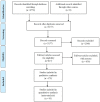Global prevalence and antibiotic resistance in clinical isolates of Stenotrophomonas maltophilia: a systematic review and meta-analysis
- PMID: 37215718
- PMCID: PMC10196134
- DOI: 10.3389/fmed.2023.1163439
Global prevalence and antibiotic resistance in clinical isolates of Stenotrophomonas maltophilia: a systematic review and meta-analysis
Abstract
Introduction: Stenotrophomonas maltophilia is a little-known environmental opportunistic bacterium that can cause broad-spectrum infections. Despite the importance of this bacterium as an emerging drug-resistant opportunistic pathogen, a comprehensive analysis of its prevalence and resistance to antibiotics has not yet been conducted.
Methods: A systematic search was performed using four electronic databases (MEDLINE via PubMed, Embase, Scopus, and Web of Science) up to October 2019. Out of 6,770 records, 179 were documented in the current meta-analysis according to our inclusion and exclusion criteria, and 95 studies were enrolled in the meta-analysis.
Results: Present analysis revealed that the global pooled prevalence of S. maltophilia was 5.3 % [95% CI, 4.1-6.7%], with a higher prevalence in the Western Pacific Region [10.5%; 95% CI, 5.7-18.6%] and a lower prevalence in the American regions [4.3%; 95% CI, 3.2-5.7%]. Based on our meta-analysis, the highest antibiotic resistance rate was against cefuroxime [99.1%; 95% CI, 97.3-99.7%], while the lowest resistance was correlated with minocycline [4·8%; 95% CI, 2.6-8.8%].
Discussion: The results of this study indicated that the prevalence of S. maltophilia infections has been increasing over time. A comparison of the antibiotic resistance of S. maltophilia before and after 2010 suggested there was an increasing trend in the resistance to some antibiotics, such as tigecycline and ticarcillin-clavulanic acid. However, trimethoprim-sulfamethoxazole is still considered an effective antibiotic for treating S. maltophilia infections.
Keywords: Stenotrophomonas maltophilia; antibiotic resistance; global; meta-analysis; prevalence.
Copyright © 2023 Banar, Sattari-Maraji, Bayatinejad, Ebrahimi, Jabalameli, Beigverdi, Emaneini and Jabalameli.
Conflict of interest statement
The authors declare that the research was conducted in the absence of any commercial or financial relationships that could be construed as a potential conflict of interest.
Figures









Comment in
-
Commentary: Global prevalence and antibiotic resistance in clinical isolates of Stenotrophomonas maltophilia: a systematic review and meta-analysis.Front Med (Lausanne). 2024 Jan 31;11:1340358. doi: 10.3389/fmed.2024.1340358. eCollection 2024. Front Med (Lausanne). 2024. PMID: 38357653 Free PMC article. No abstract available.
Similar articles
-
The prevalence of colistin resistance in clinical Stenotrophomonas maltophilia isolates worldwide: a systematic review and meta-analysis.BMC Microbiol. 2023 Jul 28;23(1):200. doi: 10.1186/s12866-023-02950-6. BMC Microbiol. 2023. PMID: 37507660 Free PMC article.
-
Characterization of Phenotypic and Genotypic Diversity of Stenotrophomonas maltophilia Strains Isolated From Selected Hospitals in Iran.Front Microbiol. 2019 May 29;10:1191. doi: 10.3389/fmicb.2019.01191. eCollection 2019. Front Microbiol. 2019. PMID: 31191502 Free PMC article.
-
Relationship between antibiotic resistance with class 1 integron and SmeDEF efflux pump encoding genes in clinical isolates of Stenotrophomonas maltophilia.J Appl Genet. 2023 Sep;64(3):591-597. doi: 10.1007/s13353-023-00776-6. Epub 2023 Aug 14. J Appl Genet. 2023. PMID: 37574492
-
A multicenter surveillance of antimicrobial resistance on Stenotrophomonas maltophilia in Taiwan.J Microbiol Immunol Infect. 2012 Apr;45(2):120-6. doi: 10.1016/j.jmii.2011.09.028. Epub 2011 Dec 11. J Microbiol Immunol Infect. 2012. PMID: 22154599
-
Update on infections caused by Stenotrophomonas maltophilia with particular attention to resistance mechanisms and therapeutic options.Front Microbiol. 2015 Sep 2;6:893. doi: 10.3389/fmicb.2015.00893. eCollection 2015. Front Microbiol. 2015. PMID: 26388847 Free PMC article. Review.
Cited by
-
Commentary: Global prevalence and antibiotic resistance in clinical isolates of Stenotrophomonas maltophilia: a systematic review and meta-analysis.Front Med (Lausanne). 2024 Jan 31;11:1340358. doi: 10.3389/fmed.2024.1340358. eCollection 2024. Front Med (Lausanne). 2024. PMID: 38357653 Free PMC article. No abstract available.
-
Optimizing Antibiotic Therapy for Stenotrophomonas maltophilia Infections in Critically Ill Patients: A Pharmacokinetic/Pharmacodynamic Approach.Antibiotics (Basel). 2024 Jun 13;13(6):553. doi: 10.3390/antibiotics13060553. Antibiotics (Basel). 2024. PMID: 38927219 Free PMC article.
-
Risk factors and clinical characteristics for Stenotrophomonas maltophilia infection in an acute care hospital in Japan: a single-center retrospective study.J Pharm Health Care Sci. 2025 Mar 28;11(1):24. doi: 10.1186/s40780-025-00429-2. J Pharm Health Care Sci. 2025. PMID: 40155984 Free PMC article.
-
Global mapping of antibiotic resistance rates among clinical isolates of Stenotrophomonas maltophilia: a systematic review and meta-analysis.Ann Clin Microbiol Antimicrob. 2024 Mar 19;23(1):26. doi: 10.1186/s12941-024-00685-4. Ann Clin Microbiol Antimicrob. 2024. PMID: 38504262 Free PMC article.
-
Clinical and microbiological features of positive blood culture episodes caused by non-fermenting gram-negative bacilli other than Pseudomonas and Acinetobacter species (2020-2023).Infection. 2025 Feb;53(1):183-196. doi: 10.1007/s15010-024-02342-6. Epub 2024 Jul 11. Infection. 2025. PMID: 38990473 Free PMC article.
References
Publication types
LinkOut - more resources
Full Text Sources

